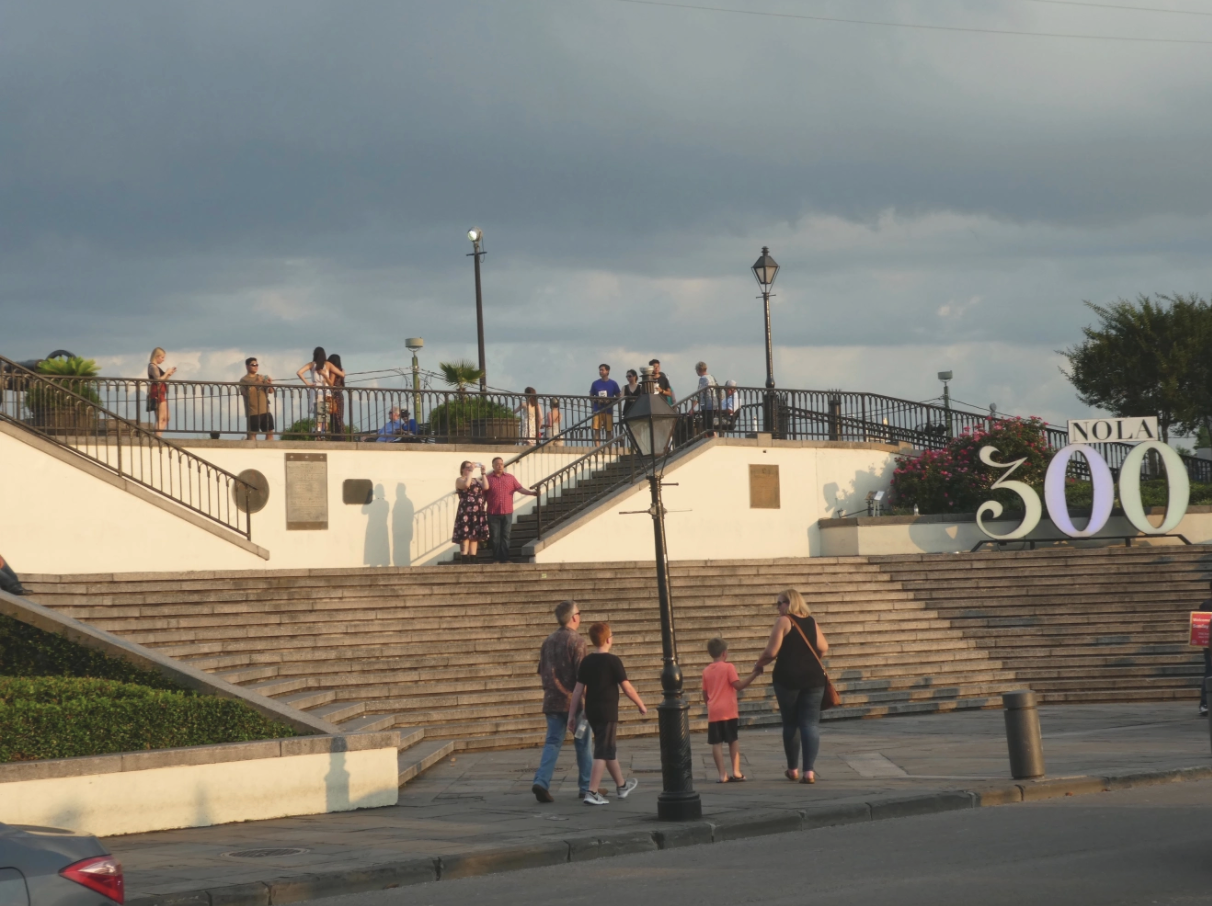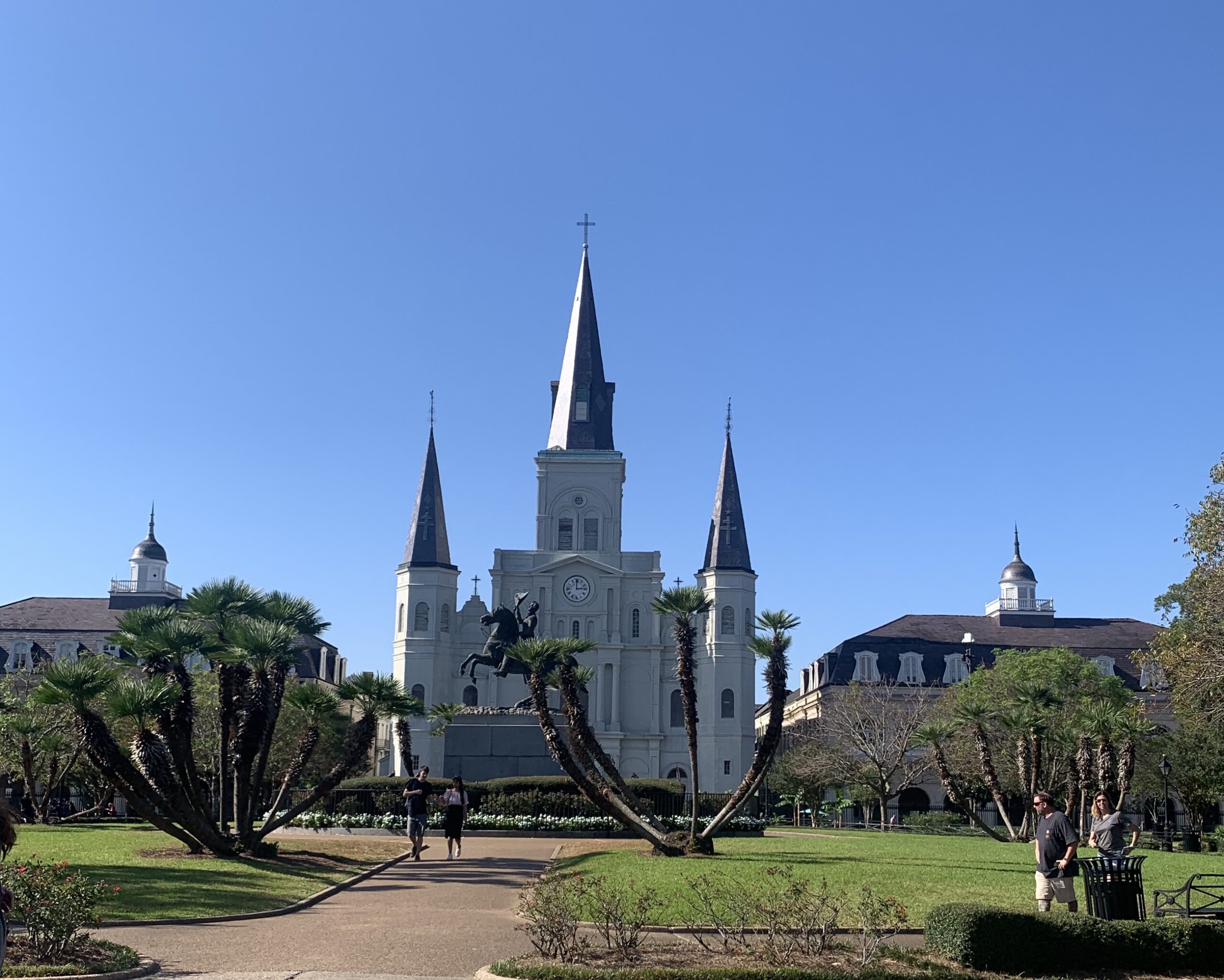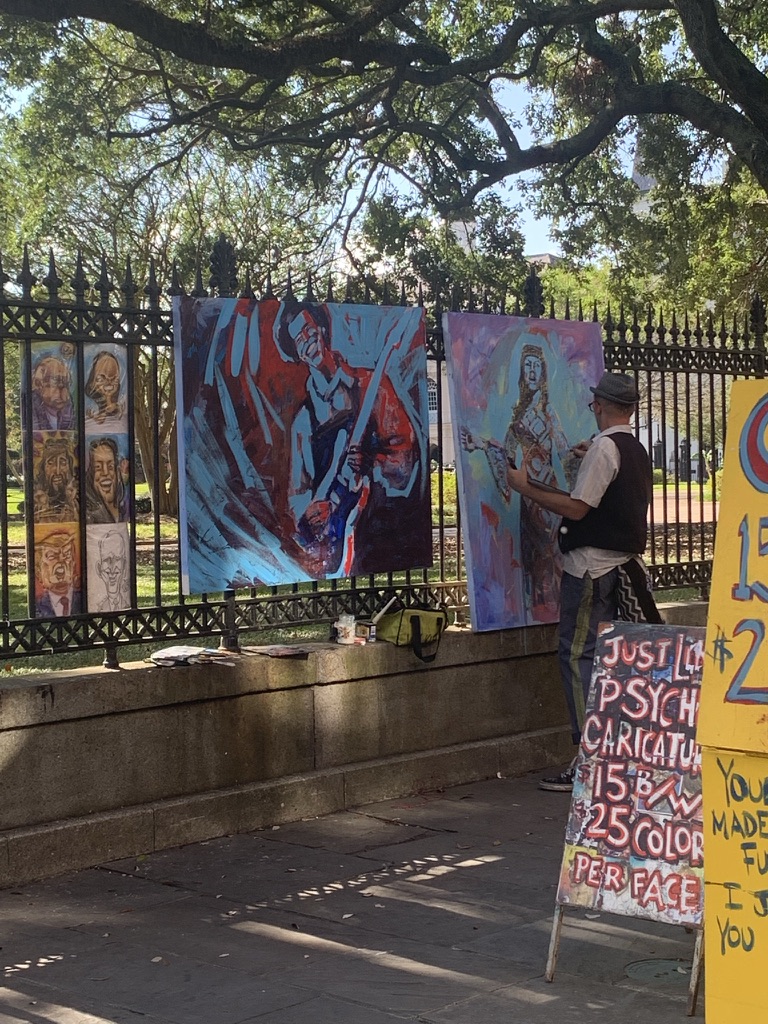A few weeks ago my mom visited me in New Orleans for the weekend. Together, we stood outside the Four Seasons, awaiting her Uber driver to pull up in his 2015 blue Nissan Odyssey. Bags in hand, my mom was heading to the airport to return to Seattle. As she packed up the car, I made a last-minute decision to get in the Uber, having the driver drop me off in the French Quarter.
I exited the car on 768 Decatur Street. In front of me lay 30 cement steps; 20 wide steps that split into smaller symmetrical staircases to the right and left. One foot after the other, I began climbing the stairs. I could feel the brisk October air going up my spine. My attention was caught by the tourists shouting “go Hawks,” climbing into the mule-drawn carriage behind me. I hadn’t known the Seahawks were playing the Saints that day and felt surprised and oddly comforted by the Seahawks chants in the background. As I took a few steps further a waft of sugar filled my nose, coming from a father and his son who were indulging in their beignets to my left.

Staircase in the French Quarter
The church bells began to ring as the clock struck the hour. Nearing the top, I veered right to the second set of steps, aimlessly holding the germy handrail. Tourists sat on the steps surrounding me, speaking a variety of languages. As I inched towards the final step, the view of the Mississippi River was revealed in the near distance, as what seemed like hundreds of people boarded the Steamboat Natchez for an afternoon jazz cruise. Having no obligations, I stood on the top of the stairs questioning what direction my day would take.
By going down the stairs and to the right you will reach the Original Cafe Du Monde. Established in 1862, Cafe Du Monde is a 24-hour traditional coffee shop. This quintessential cafe has stuck to its roots, barely changing its menu since the Civil War: beignets, coffee, hot chocolate, milk, fresh-squeezed orange juice, plus the recent addition of soft drinks. With a small list of menu items, Cafe Du Monde allows customers to make choices for themselves without feeling overwhelmed.
Psychologists Judith Rodin and Ellen Langer find by exercising control, one maximizes their utility, uplifting their mood and inducing greater feelings of confidence. Further, they state individuals gain this sense of control by having and making choices. By choosing between their famous Cafe Au Lait or hot chocolate to accompany the beignets, Cafe Du Monde provides a space to feel in control amidst a chaotic city. However, one’s sense of control can be challenged by the messy powdered sugar that leaves everything sticky – the tables, the chairs, the floor, and one’s fingers. Whether you order beignets or not, the sugary residue left on the counter by the most popular menu item is unavoidable.
Control can be analyzed in many different layers, or in this case, steps. Sociology professor Jong Hyun Jung states that one of the steps on the staircase to control is prayer and religious attendance. By walking down the center of these French Quarter steps and forward a few blocks, you will find the St. Louis Cathedral, the oldest continuously active Roman Catholic Cathedral in the United States. Dedicated to Louis IX, New Orleanians have prayed in churches on this site since 1727. The Cathedral is open to the public daily from 9:00 am until 4:00 pm, and Daily Mass occurs at 12:05 pm.

St. Louis Cathedral
“Religious attendance can be a pathway to a greater sense of control in a number of ways,” Jung contends. Through numerous types of prayers, religious people undergo personal, intimate relationships with divine figures. Many people pray to God to find solutions to personal problems, and “viewed in this way, religious persons may believe that they can positively influence their situations through prayer, which bolsters a vicarious type of internal control over their lives.” Surrounded by the beautiful paintings and stained glass windows, and praying facing the Rococo-style, gilded altar, the St. Louis Cathedral provides the perfect space to connect with God, gaining a deeper sense of control in life.
The next step to gain control is through practicing choice. In the article “Born to Choose: The Origins and Value of the Need for Control,” Lauren Leotti, Sheena Lyengar, and Kevin Ochsner claim that having control is necessary for survival, and “opportunities for choice have been shown to create the illusion of control.” Choices arise between the steps and the cathedral where numerous artists set up booths surrounding Jackson Square.
New Orleans native, MOUSIE, has been creating art in Jackson Square since 1977. MOUSIE portrays “The Magic, The Mystery, and the Pageantry” of New Orleans through watercolor paintings, portraits, and caricatures. Another long-time artist, Miriam Ragan, has painted in the French Quarter for over 30 years. Her paintings depict a wide array of subjects, but she specializes in painting scenes from the French Quarter, Louisiana swamps, and southern flowers. Brandon Jenkins draws 30s and 40s nightlife scenes, Jason Jones oxidizes steel to make unique, abstract works, Barbara Yochmun, inspired by magic, creates paintings of mermaids, angels, and fairies, and the list of artists goes on. By having choices, humans are “conducive to achieving desirable outcomes and avoiding undesirable outcomes,” and the choices surrounding Jackson Square are countless. Amongst the broad range of artistic talent, consumers are allowed to exert control over the environment; they discover what they like and don’t like, what they want to buy, and what they can live without.

Artist in Jackson Square
Being atop these stairs places you at the epicenter of opportunities for exercising control, whether that be through choosing what to order at Cafe du Monde, praying at the St. Louis Cathedral, or exploring the myriad artists surrounding Jackson Square. However, there are many aspects of this space that are out of our control, which can lead individuals to “feelings of helplessness and depression.”
With over 22,000 hotel rooms in the downtown area and an additional 38,000 throughout the city, New Orleans welcomes approximately 19.75 million visitors each year. Surrounded by “can’t miss” tourist destinations like Bourbon Street, Cafe Du Monde, and the St. Louis Cathedral, it is likely thousands of people walk up, down, and around these stairs every day. In a tourist-driven city like New Orleans, crowds are inevitable and beyond the control of any single person.
Dumping rain, high-speed winds, and unruly humidity – New Orleans has it all. From May until September, New Orleans surpasses 100 degree days with 98% humidity, making it unbearable to be outside. The wind picks up for 8 months of the year, from September to May, and March, New Orleans’ windiest month, has an average hourly wind speed of 10.8 miles per hour. As well, New Orleans receives 5 inches of rain a month on average, which combined with the wind, can create deadly hurricanes that bestow danger on the city’s citizens and infrastructure. The unpredictable weather patterns are part of what New Orleans is known for, and they come and go at the expense of our well-being.
When coming to this area it is also important to be wary of New Orleans’ crime rates, which are 150% higher than the national average. On average, each year there are 661 assaults, 30 murders, 196 rapes, and 256 acts of robbery per 100,000 New Orleans residents. Just a few months ago, in August 2021, five people were shot on Bourbon Street just two blocks away from these steps, killing one person.
Though crime in New Orleans is decreasing each year, recent incidents have encouraged reporters to call the area a “shooting gallery,” warning tourists and locals to be careful. The city, which law enforcement experts say needs 1,600 police officers, has only 1,150 on duty. If the New Orleans Police Department is unable to control the crime, I don’t know who else can. When visiting this space individuals have no control over the crime taking place and must be aware of their surroundings.
I began to see the clouds turn pink as the sun set atop the River. The crowds were beginning to shift from innocent families to wild party-goers, and after seeing the second round of bachelorettes roll through, I knew it was time to head back. As I descended the steps, my mind returned to reality: I have to study for my test, I need to do my laundry, I have to clean my dishes, I have to go to the grocery store, etc. Perfectly timed, my Uber arrived as I took my final step down. I got in the car and watched the magical city disappear into the distance as I returned uptown. It was a great day.
 NOLAbeings
Multimedia artist Claire Bangser created NOLAbeings as a portrait-based story project that marries...
NOLAbeings
Multimedia artist Claire Bangser created NOLAbeings as a portrait-based story project that marries...
 Data corner: Adobe Suite (create a PDF, social media graphic, presentation, edit a photo and video
Data corner is where you go to work with analytics and top tech skills. It takes on everything from PERL and SQL to Canva and Sprout Social.
Data corner: Adobe Suite (create a PDF, social media graphic, presentation, edit a photo and video
Data corner is where you go to work with analytics and top tech skills. It takes on everything from PERL and SQL to Canva and Sprout Social.
